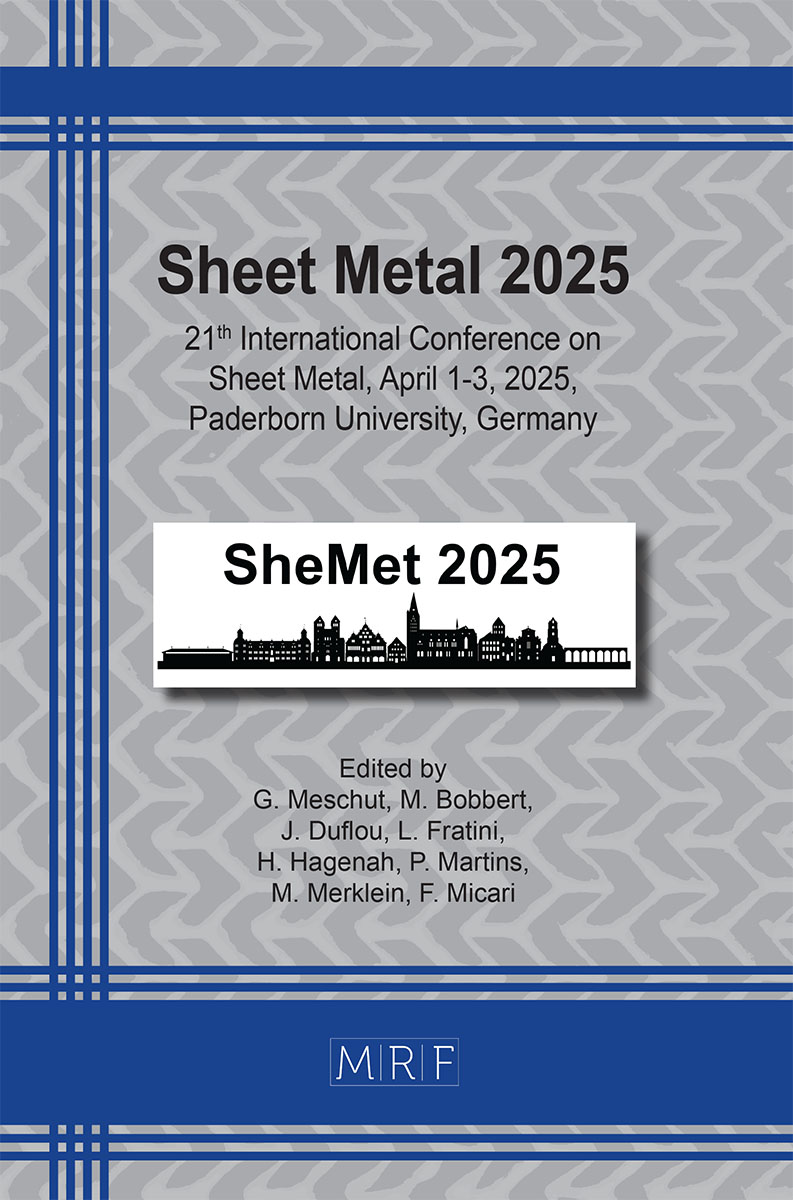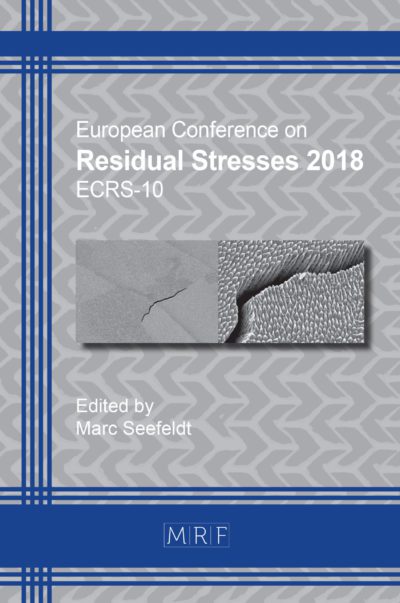Processing of the hypoeutectic AlSi9 alloy with twin-roll casting by using copper shells
Moritz Neuser, Kay-Peter Hoyer, Mirko Schaper
Abstract. Lightweight design is one of the central topics of the automotive industry since reducing mass can save emissions over the entire life cycle of a component. Nowadays, vehicle structures usually consist of a multi-material design, which poses the additional challenge of joining these different materials. Mechanical joining is the most common way of joining different types of materials. Cast aluminium alloys of the AlSi system have a low ductility, which causes cracks during the mechanical joining process in the joint. One research approach is to achieve a fine microstructure by influencing the solidification rate since this results in increased mechanical properties, specifically the elongation at fracture and yield strength. A very fine microstructure can be achieved by utilizing Twin-roll casting (TRC) which is a continuous casting process in which high solidification rates of more than 100 K/s occur. In this study, the hypoeutectic cast aluminium alloy AlSi9 is processed in the TRC process using copper rollers. The cast strips are investigated regarding the microstructure-property correlation. A variation of the roller materials and cooling conditions allows for an increase in the solidification rate, whereby a defined, fine microstructure can be achieved, which enhances the mechanical properties of the hypoeutectic aluminium casting alloys.
Keywords
Aluminium, Microstructure, Twin-Roll Casting
Published online 4/1/2025, 10 pages
Copyright © 2025 by the author(s)
Published under license by Materials Research Forum LLC., Millersville PA, USA
Citation: Moritz Neuser, Kay-Peter Hoyer, Mirko Schaper, Processing of the hypoeutectic AlSi9 alloy with twin-roll casting by using copper shells, Materials Research Proceedings, Vol. 52, pp 210-219, 2025
DOI: https://doi.org/10.21741/9781644903551-26
The article was published as article 26 of the book Sheet Metal 2025
![]() Content from this work may be used under the terms of the Creative Commons Attribution 3.0 license. Any further distribution of this work must maintain attribution to the author(s) and the title of the work, journal citation and DOI.
Content from this work may be used under the terms of the Creative Commons Attribution 3.0 license. Any further distribution of this work must maintain attribution to the author(s) and the title of the work, journal citation and DOI.
References
[1] httpLeichtbau in der Fahrzeugtechnik; Friedrich, H.E., Ed.; Springer Fachmedien Wiesbaden: Wiesbaden, 2017.
[2] httpMallick, P.K. Materials, Design and Manufacturing for Lightweight Vehicles, 2nd ed.; Elsevier Science & Technology: San Diego, 2021, ISBN 978-0-12-819029-6.
[3] httpLumley, R.N. Fundamentals of aluminium metallurgy: Production, processing and applications; Woodhead Publishing: Cambridge, MA, 2018, ISBN 978-0-08-102063-0.
[4] httpHatch, J.E. Aluminum: Properties and physical metallurgy; American Society for Metals: Metals Park, OH, 1984, ISBN 1615031693.
[5] httpD. Vojtech, J. Serak, O. Ekrt. Improving the casting properties of high-strength aluminium alloys. Materiali In Tehnologije 2004, 38, 99-102.
[6] httpAdvanced Light Alloys and Composites; Ciach, R., Ed.; Springer: Dordrecht, 1998, ISBN 9789401590686.
[7] httpNeuser, M.; Grydin, O.; Andreiev, A.; Schaper, M. Effect of solidification rates at sand casting on the mechanical joinability of a cast aluminium alloy. Metals 2021, 11, 1304, doi:10.3390/met11081304. https://doi.org/10.3390/met11081304
[8] httpNeuser, M.; Grydin, O.; Frolov, Y.; Schaper, M. Influence of solidification rates and heat treatment on the mechanical performance and joinability of the cast aluminium alloy AlSi10Mg. Prod. Eng. Res. Devel. 2022, 1-10. https://doi.org/10.1007/s11740-022-01106-1
[9] httpNeuser, M.; Kappe, F.; Ostermeier, J.; Krüger, J.T.; Bobbert, M.; Meschut, G.; Schaper, M.; Grydin, O. Mechanical Properties and Joinability of AlSi9 Alloy Manufactured by Twin‐Roll Casting. Adv Eng Mater 2022, 24, 2200874. https://doi.org/10.1002/adem.202200874
[10] httpFredriksson, H.; Åkerlind, U. Solidification and crystallization processing in metals and alloys; John Wiley & Sons, Ltd: Chichester, UK, 2012. https://doi.org/10.1002/9781119975540
[11] httpKaufman, J.G.; Rooy, E.L. Aluminum alloy castings: Properties, processes, and applications; ASM International: Materials Park, OH, 2004, ISBN 1615030476. https://doi.org/10.31399/asm.tb.aacppa.9781627083355
[12] httpVossel, T.; Wolff, N.; Pustal, B.; Bührig-Polaczek, A. Influence of Die Temperature Control on Solidification and the Casting Process. Inter Metalcast 2020, 14, 907-925. https://doi.org/10.1007/s40962-019-00391-4
[13] httpBarekar, N.S.; Dhindaw, B.K. Twin-Roll Casting of Aluminum Alloys – An Overview. Materials and Manufacturing Processes 2014, 29, 651-661. https://doi.org/10.1080/10426914.2014.912307
[14] httpDaamen, M.; Güvenç, O.; Bambach, M.; Hirt, G. Development of efficient production routes based on strip casting for advanced high strength steels for crash-relevant parts. CIRP Annals 2014, 63, 265-268. https://doi.org/10.1016/j.cirp.2014.03.025
[15] httpDaamen, M.; Haase, C.; Dierdorf, J.; Molodov, D.A.; Hirt, G. Twin-roll strip casting: A competitive alternative for the production of high-manganese steels with advanced mechanical properties. Materials Science and Engineering: A 2015, 627, 72-81. https://doi.org/10.1016/j.msea.2014.12.069
[16] httpHaga, T.; Takahashi, K.; Ikawa, M.; Watari, H. A vertical-type twin roll caster for aluminum alloy strips. Journal of Materials Processing Technology 2003, 140, 610-615. https://doi.org/10.1016/S0924-0136(03)00835-5
[17] httpHaga, T.; Inui, H.; Watari, H.; Kumai, S. Casting of Al-Si hypereutectic aluminum alloy strip using an unequal diameter twin roll caster. Journal of Materials Processing Technology 2007, 191, 238-241. https://doi.org/10.1016/j.jmatprotec.2007.03.012
[18] httpGrydin, O.; Neuser, M.; Schaper, M. Influence of Shell Material on the Microstructure and Mechanical Properties of Twin-Roll Cast Al-Si-Mg Alloy. In Proceedings of the 14th International Conference on the Technology of Plasticity – Current Trends in the Technology of Plasticity: ICTP 2023 – Volume 3, 1st ed.; Mocellin, K., Ed.; Springer: Cham, 2024; pp 589-596, ISBN 978-3-031-41340-7. https://doi.org/10.1007/978-3-031-41341-4_61
[19] httpDaamen, M.; Förster, T.; Hirt, G. Experimental and numerical investigation of double roller casting of strip with profiled cross section. Special Edition: 10th International Conference on Technology of Plasticity, ICTP 2011 2011, 93-98.
[20] httpSpathis, D.; Clemente, A.; Tsiros, J.; Arvanitis, A.; Wobker, H.-G. The use of copper shells by Twin Roll Strip Casters. TMS Light Metals 2010.
[21] httpTalaat, E.-B.; Fredriksson, H. Solidification Mechanism of Unmodified and Strontium Modified Al-Si Alloys. Materials Transactions JIM 2000, 41, 507-515. https://doi.org/10.2320/matertrans1989.41.507
[22] httpGrydin, O., Yu.; Ogins’kyy, Y., K.; Danchenko, V.M.; Bach, F.-W. Experimental Twin-Roll Casting Equipment for Production of Thin Strips. Metallurgical and Mining Industry 2010, 2.
[23] httpNeuser, M.; Böhnke, M.; Grydin, O.; Bobbert, M.; Schaper, M.; Meschut, G. Influence of heat treatment on the suitability for clinching of the aluminium casting alloy AlSi9. Proceedings of the Institution of Mechanical Engineers, Part L: Journal of Materials: Design and Applications 2022, 146442072210758. https://doi.org/10.1177/14644207221075838
[24] httpEbhota, W.S.; Jen, T.-C. Effects of modification techniques on mechanical properties of Al-Si cast alloys. In Aluminium Alloys – Recent Trends in Processing, Characterization, Mechanical Behavior and Applications; Sivasankaran, S., Ed.; InTechOpen: Rijeka, Croatia, 2017, ISBN 978-953-51-3697-2. https://doi.org/10.5772/intechopen.70391
[25] httpPezda, J. A R C H I V E S of 24/3 Effect of modifying process on mechanical properties of EN AC-43300 silumin cast into sand moulds. Archives of Foundry Engineering 2009, 9.














